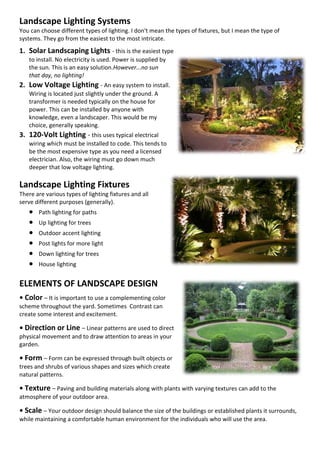The 5-Minute Rule for Hilton Head Landscapes
The 5-Minute Rule for Hilton Head Landscapes
Blog Article
The smart Trick of Hilton Head Landscapes That Nobody is Discussing
Table of ContentsThe Only Guide for Hilton Head LandscapesSee This Report on Hilton Head LandscapesIndicators on Hilton Head Landscapes You Should KnowThe Ultimate Guide To Hilton Head LandscapesThe 6-Minute Rule for Hilton Head LandscapesFascination About Hilton Head LandscapesThings about Hilton Head Landscapes
Line creates all kinds and patterns and can be utilized in a variety of ways in the landscape. Line in the landscape is developed by the edge in between two materials, the outline or shape of a type, or a long linear function. Lines are an effective tool for the developer since they can be utilized to develop a boundless range of shapes and kinds, and they regulate activity of the eye and the body.

Lines can have one or more attributes, such as those described listed below, yet they generally serve various functions. Figure 1. Lines in the landscape - hilton head landscapers. The residential properties of lines determine how individuals react to the landscape, both psychologically and physically. Straight lines are architectural and forceful; they create an official personality, are generally associated with a balanced style, and lead the eye directly to a centerpiece.
Getting The Hilton Head Landscapes To Work
Straight lines are usually found in hardscape edges and product. Bent lines create an informal, all-natural, kicked back character that is connected much more with nature and asymmetrical equilibrium. Rounded lines move the eye at a slower pace and add secret to the room by creating hidden views. Upright lines relocate the eye up, making an area really feel larger.
Upright lines in the landscape include high, narrow plant product, such as trees, or tall structures, such as an arbor or a bird residence on a pole. Horizontal lines relocate the eye along the ground aircraft and can make a room really feel bigger. Reduced lines are more suppressed and produce a feeling of rest or repose.
The Facts About Hilton Head Landscapes Revealed
Low lines are developed by reduced yard walls, sidewalks, and short bushes. Lines are utilized to attract forms on a strategy. In strategy view, they define plant beds and hardscape locations. Lines are additionally developed by the vertical forms of constructed functions and plant material. There are 3 main line types that create form in the landscape: bedlines, hardscape lines, and plant lines.
Bedlines attach plant material to your house and hardscape since the eye adheres to the line, relocating the stare via the landscape. Hardscape lines are produced by the edge of the hardscape, which defines the constructed structure. Line can additionally be created by long and slim materials, such as a fence or wall surface.
Everything about Hilton Head Landscapes
Type is located in both hardscape and plants, and it is generally the dominant visual component that spatially arranges the landscape and often identifies the design Go Here of the yard. The kind of structures, plant beds, and garden ornaments likewise establishes the total form theme of the yard. Formal, geometric types include circles, squares, and polygons.
Plants produce type in the yard via their details or silhouettes, yet kind can likewise be defined by a void or unfavorable area in between plants - landscapers in bluffton sc (https://h1tnhdlndscps.wordpress.com/2024/07/03/transform-your-outdoor-space-with-hilton-head-landscapers/). Circles can be cycles, or they can be split into half circles or circle sections and integrated with lines to produce arcs and tangents
What Does Hilton Head Landscapes Do?
Circles can likewise be stretched into ovals and ellipses for even more range and passion. Circles are a strong design form due to the fact that the eye is always attracted to the center, which can be made use of to emphasize a prime focus or connect various other forms. Number 2. Circular types in hardscape and yard panels.
The square type can additionally be fractional and previously owned continuously to produce a grid pattern. Unlike circles, squares are stronger on the edges, which can be aligned or overlapped to produce one-of-a-kind patterns and even more complicated kinds. Polygons are many-sided forms with straight sides. Triangles, for instance, are three-sided polygons.
Twisting lines usually simulate the all-natural course of rivers or streams and can be referred to as smooth lines with deeply bent undulations. Meandering lines (Figure 3) work well for pathways, plant bedlines, and completely dry stream beds. Meandering lines can add passion and enigma to a garden by leading audiences around corners to uncover brand-new sights and areas.
Some Known Questions About Hilton Head Landscapes.

Number 5. Fragmented edges: stepping rocks in pathway. Kind is the most long-lasting high quality of a plant (Landscapers near me). https://moz.com/community/q/user/h1tnhdlndscps?_=1719959081810. Typical plant forms are well established and standardized, as kind is the most constant and identifiable quality of plants. Form can additionally be developed through the massing of plants, where the overall mass develops a various type than an individual plant.
A highly contrasting kind needs to be utilized with careone or more job well as a prime focus, yet way too many wreak havoc. Natural plant kinds, as opposed to over-trimmed types, should establish the mass of the composition. The relevance of general type is essentially depending on the watching perspectivethe kind of a tree can appear quite different to a person standing under the canopy versus viewing the tree from a distance in an open field.
The 6-Minute Rule for Hilton Head Landscapes
Plant types additionally develop and specify deep space or open rooms between the plants, producing either convex or scooped kinds in the voids. High-arching tree branches commonly produce a concave open space under the branches, and a rounded canopy with reduced branches fills the space to create a convex form in the open room under the tree.

Report this page